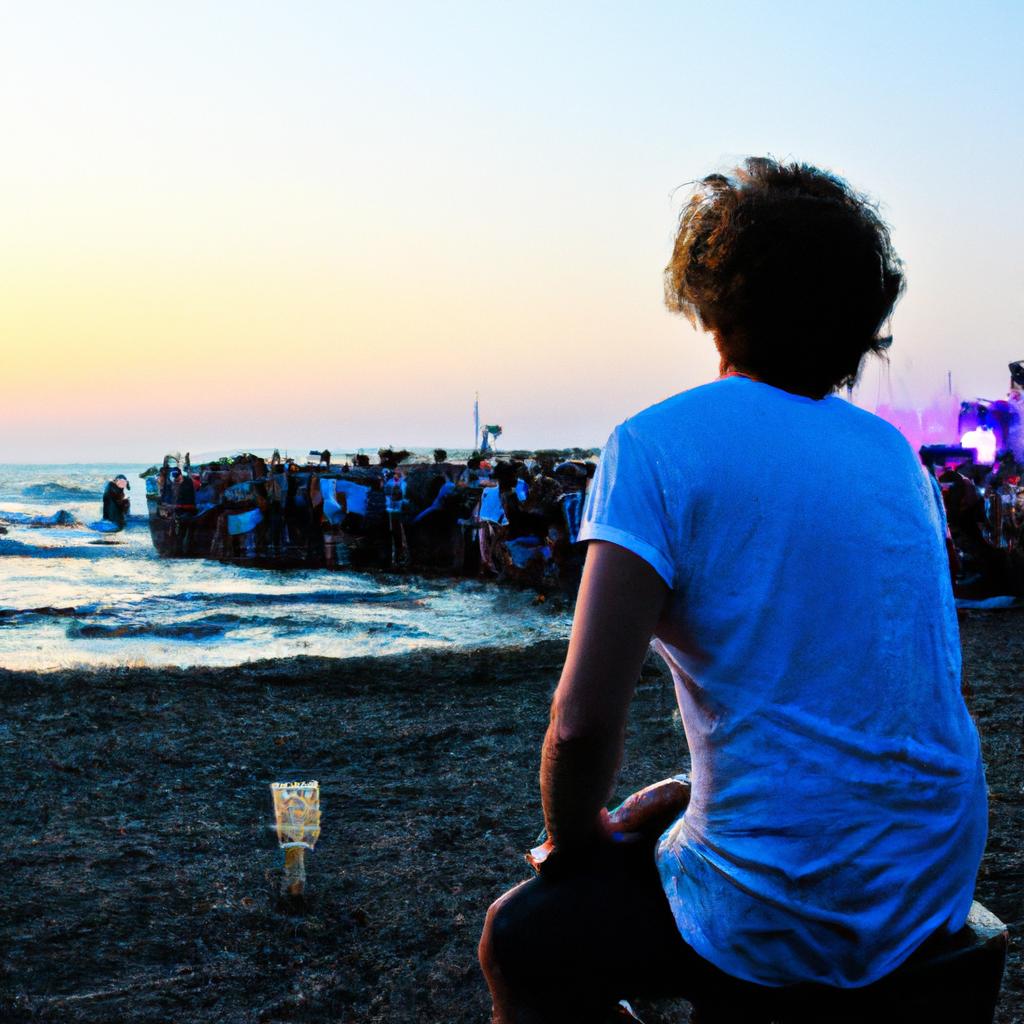Open-air Festivals: Destination Events for Outdoor Concerts

The popularity of open-air festivals has grown significantly in recent years, as they have emerged as destination events for outdoor concerts. These festivals provide a unique and immersive experience for music enthusiasts, blending the joy of live performances with the beauty of nature. One example that showcases the success of these events is the renowned Coachella Valley Music and Arts Festival held annually in California. With its picturesque desert setting and impressive lineup of artists, Coachella has become an iconic event that attracts thousands of attendees from around the world.
Open-air festivals offer a distinct appeal compared to traditional indoor concerts. The combination of music, fresh air, and natural surroundings creates an atmosphere that enhances both the audience’s enjoyment and their connection to the music. Unlike indoor venues that often have space limitations, open-air locations allow for larger crowds and more expansive stages, providing performers with greater creative freedom. Additionally, these festivals often incorporate various art installations, food vendors, and interactive attractions further enriching the overall experience for festival-goers. As a result, open-air festivals have gained a reputation not only for showcasing top-tier musical acts but also for fostering a vibrant community spirit among attendees.
Benefits of Open-air Festivals
Imagine attending an open-air music festival on a warm summer evening, surrounded by breathtaking scenery and the energy of thousands of passionate fans. One such example is the Coachella Valley Music and Arts Festival in California, which attracts attendees from around the world with its impressive lineup of performers and unique outdoor setting. Open-air festivals like these offer numerous benefits that make them destination events for outdoor concerts.
Firstly, one significant benefit of open-air festivals is their ability to create a sense of community among attendees. The shared experience of being outdoors, immersed in live music, fosters a feeling of belonging and connection. This communal atmosphere cultivates friendships and allows individuals to form lasting memories together. Moreover, the festive ambiance encourages people to engage with others who share similar interests, resulting in new social connections and potential networking opportunities.
Secondly, open-air festivals provide an opportunity for artists to showcase their talent in a dynamic environment. Performing outdoors allows musicians to connect more intimately with their audience as they interact under an expansive sky or against stunning natural backdrops. This enhances the overall concert experience for both artist and attendee alike. Additionally, the open space permits creative staging options, including large-scale art installations or immersive visuals that complement the musical performances.
Furthermore, open-air festivals often offer a diverse range of activities beyond just live music. Attendees can explore various food stalls serving local cuisine or participate in workshops showcasing different artistic forms such as painting or dance. These additional attractions enhance the overall festival experience by providing avenues for personal growth and cultural enrichment.
To illustrate this further:
- Immerse yourself: Lose yourself in captivating melodies while enjoying panoramic views.
- Connect with others: Forge new relationships based on shared passion for music.
- Engage your senses: Indulge in delectable culinary delights amidst vibrant surroundings.
- Discover new art forms: Unleash your creativity through interactive workshops.
Moreover, here is an example of a table highlighting the benefits:
| Benefits of Open-air Festivals |
|---|
| Sense of community |
| Intimate artist-audience connection |
| Diverse range of activities |
| Cultural and artistic enrichment |
In conclusion, open-air festivals offer several advantages that make them highly sought-after destination events for outdoor concerts. The communal atmosphere, intimate artist-audience connections, diverse activities, and cultural enrichment contribute to an unforgettable experience. In the following section, we will explore some of the top open-air festivals around the world, showcasing their unique features and attractions.
Top Open-air Festivals Around the World
As we have explored the benefits of open-air festivals, it is evident that these events offer a unique and captivating experience. Now, let us delve into some notable open-air festivals around the world, showcasing how they attract visitors with their diverse offerings.
- Glastonbury Festival (Somerset, England): One prime example of an open-air festival is the renowned Glastonbury Festival held annually in Somerset, England. With its origins dating back to 1970, this festival has become an iconic event celebrated by music enthusiasts from across the globe. Offering a wide range of musical genres performed on multiple stages, attendees are immersed in a vibrant atmosphere that transcends boundaries and fosters unity through shared love for music.
- An overwhelming sense of euphoria as you sway to live performances under the stars.
- The thrill of discovering emerging artists and experiencing their raw talent firsthand.
- A deep connection formed between like-minded individuals who share your passion for music.
- Unforgettable memories created amidst breathtaking natural landscapes.
- Table Mountain Blues Summit (Cape Town, South Africa): Another mesmerizing example takes us to Cape Town, South Africa – home to the Table Mountain Blues Summit. Against the backdrop of one of nature’s most awe-inspiring wonders, this festival blends blues music with panoramic views that stir the soul. From local talents to international acts gracing the stage, attendees immerse themselves in both auditory and visual delights.
Table: Open-Air Festivals Around the World
| Festival | Location | Genre |
|---|---|---|
| Tomorrowland | Boom, Belgium | Electronic Dance Music |
| Coachella Valley Music | Indio, California | Various Genres |
| and Arts Festival | ||
| Fuji Rock Festival | Niigata Prefecture, | Rock and Alternative Music |
| Japan |
- Coachella Valley Music and Arts Festival (Indio, California): Moving across continents to Indio, California, we encounter the renowned Coachella Valley Music and Arts Festival. Drawing in music lovers from diverse backgrounds, this festival has established itself as a cultural phenomenon with its eclectic lineup of performers spanning various genres. From rock to hip-hop, electronic dance music to indie pop, attendees revel in an immersive experience that celebrates both visual arts and live performances.
In conclusion: Open-air festivals provide a platform for artists to showcase their talents while offering audiences an opportunity to engage with music on a deeper level. As we move forward, let us explore some essential tips for attending these vibrant events and make the most out of our open-air festival experiences.
Transition into subsequent section about “Tips for Attending Open-air Festivals”: With an understanding of the allure surrounding open-air festivals worldwide, it is crucial to equip ourselves with valuable insights on how best to navigate these captivating events. Let us now delve into some practical tips that will enhance your overall enjoyment when attending such destination concerts.
Tips for Attending Open-air Festivals
Transitioning from the previous section where we explored some of the top open-air festivals around the world, let us now delve into some valuable tips that can enhance your experience when attending these outdoor concerts. To illustrate this further, let’s consider a hypothetical scenario involving an individual named Alex who is planning to attend their first open-air festival.
Firstly, it is crucial to come prepared and ensure you have all the necessary essentials for a comfortable and enjoyable experience. Some items that should be on your packing list include:
- Sunscreen to protect your skin from harmful UV rays
- A hat or cap to shield yourself from the sun
- Comfortable footwear for walking and standing throughout the day
- A portable charger or power bank to keep your electronic devices charged
Furthermore, familiarize yourself with the event schedule beforehand in order to plan your day effectively. Most open-air festivals offer various stages featuring different artists simultaneously. By studying the lineup and stage times, you can prioritize performances you do not want to miss while also allowing time for breaks, meals, and exploring other attractions within the festival grounds.
Additionally, staying hydrated is essential during any outdoor event. Make sure to bring a refillable water bottle as most festivals provide free water stations. Remembering to drink water regularly will help prevent dehydration and allow you to fully enjoy each performance without feeling fatigued.
To summarize these important tips:
- Pack sunscreen, a hat or cap, comfortable footwear, and a portable charger.
- Familiarize yourself with the event schedule before attending.
- Stay hydrated by bringing a refillable water bottle.
In conclusion, following these suggestions will greatly enhance your experience at open-air festivals like Alex did in our example scenario. By being well-prepared and informed about what lies ahead, you can maximize enjoyment while minimizing potential inconveniences during such events.
[Table]
| Packing Checklist | |
|---|---|
| Sunscreen | A hat or cap |
| Comfortable footwear | Portable charger |
| Festival schedule | Refillable water bottle |
With these tips in mind, let us now explore the fascinating history of open-air festivals and how they have evolved over time.
The History of Open-air Festivals
As the popularity of open-air festivals continues to grow, more and more music lovers are flocking to these destination events for a unique concert experience. One such example is the renowned Glastonbury Festival in England, which attracts thousands of attendees every year. These festivals offer an opportunity to enjoy live music in a picturesque outdoor setting while immersing oneself in a vibrant atmosphere.
Attending open-air festivals provides an array of benefits and attractions that make them stand out from traditional indoor concerts:
- Connection with nature: Being surrounded by lush green fields or breathtaking landscapes enhances the overall ambiance of the event, creating a sense of harmony between music and natural surroundings.
- Sense of community: Open-air festivals bring together people from various backgrounds who share a common love for music. The communal spirit fosters connections among attendees, leading to lasting friendships forged amidst unforgettable performances.
- Freedom and exploration: Unlike indoor venues with limited space, open-air festivals often encompass vast grounds where attendees can freely roam, discover new artists on smaller stages, try different food options at pop-up stalls, or engage in diverse activities beyond just watching performances.
- Unforgettable memories: The combination of captivating music, stunning visuals, and the energy exuded by both artists and fellow festival-goers creates an indelible imprint on one’s memory. Whether it’s singing along to favorite songs under starlit skies or dancing with abandon in the midst of a crowd, these moments become cherished memories that last a lifetime.
To further illustrate the appeal of open-air festivals compared to indoor concerts, consider the following table showcasing some key differences:
| Aspect | Open-Air Festivals | Indoor Concerts |
|---|---|---|
| Venue | Wide-open spaces | Confined halls |
| Atmosphere | Lively and energetic | More intimate |
| Performances | Multiple stages | Main stage focus |
| Weather factor | Outdoor elements | Climate-controlled |
These factors contribute to the unique draw of open-air festivals, making them a popular choice for music enthusiasts seeking an immersive and unforgettable experience. In the subsequent section on “Open-air Festivals vs. Indoor Concerts,” we will explore in more detail how these two types of events differ in terms of ambiance, audience engagement, and artist performances.
Open-air Festivals vs. Indoor Concerts
Imagine attending a music festival on a warm summer day, surrounded by nature and the fresh outdoor air. The energy of the crowd palpable as you listen to your favorite bands perform live under an open sky. This experience is what draws thousands of music enthusiasts to open-air festivals each year. In this section, we will explore the key differences between open-air festivals and indoor concerts, highlighting why these destination events have become increasingly popular.
-
Ambiance and Setting:
One significant advantage of open-air festivals over indoor concerts is the unique ambiance they provide. With vast landscapes or iconic city backdrops serving as the stage, attendees are immersed in breathtaking surroundings that enhance their overall experience. For instance, consider Glastonbury Festival held annually at Worthy Farm in Somerset, England. Surrounded by rolling green hills, this renowned event offers attendees a picturesque setting unlike any traditional concert venue. -
Capacity and Scale:
Open-air festivals often boast larger capacities compared to indoor venues due to the expansive space available outdoors. This allows for a greater number of attendees who can enjoy multiple stages simultaneously without feeling overcrowded. Moreover, the scale of open-air festivals enables organizers to curate diverse lineups featuring both established artists and emerging talent from various genres. -
Freedom and Flexibility:
Another notable difference lies in the freedom and flexibility offered at open-air festivals. Unlike indoor concerts with fixed seating arrangements, these events typically allow participants to move around more freely while enjoying different performances or exploring food stalls and art installations scattered throughout the grounds. Attendees have the liberty to create their own personalized schedules based on their interests and preferences. -
Community Spirit:
The communal atmosphere fostered by open-air festivals cannot be replicated in indoor settings. These events bring together people from all walks of life who share a common love for music and culture. They create spaces where strangers become friends through shared experiences, creating lasting memories and connections. The sense of community and camaraderie adds an emotional dimension to the festival experience.
Table: Emotional Impact of Open-air Festivals
| Emotions Evoked | Examples |
|---|---|
| Excitement | Dancing in a crowd to your favorite band |
| Joy | Singing along with thousands of fellow fans |
| Wonder | Being awe-inspired by stunning visual displays |
| Togetherness | Bonding with friends over shared musical tastes |
Open-air festivals offer a distinct experience that sets them apart from indoor concerts. From the captivating ambiance created by natural surroundings to the freedom for attendees to explore and connect, these events have captured the hearts of music lovers worldwide.
Understanding the unique qualities that make open-air festivals so appealing, it is clear why these destination events hold significant potential for boosting local tourism.
How Open-air Festivals Promote Local Tourism
In recent years, open-air festivals have gained immense popularity as immersive cultural experiences that offer a unique blend of music, art, and nature. These destination events provide attendees with an opportunity to enjoy live performances in picturesque outdoor settings while fostering a sense of community among festival-goers. This section explores the captivating aspects of open-air festivals and highlights their ability to create memorable experiences for both locals and tourists.
To illustrate the appeal of open-air festivals, let us consider the hypothetical case study of “Harmony Fest” held annually in a scenic valley surrounded by majestic mountains. Over the course of three days, this event attracts music enthusiasts from around the world who come together to celebrate various genres ranging from rock and pop to folk and jazz. As visitors immerse themselves in the vibrant atmosphere created by talented artists and enthusiastic crowds, they are transported into a realm where music becomes more than just entertainment – it becomes a shared language connecting individuals across different cultures and backgrounds.
Open-air festivals captivate audiences through several key elements:
- Natural surroundings: The breathtaking landscapes serve as an awe-inspiring backdrop for concerts, transforming them into unforgettable moments that merge human creativity with natural beauty.
- Sense of freedom: Unlike indoor venues, open-air festivals allow attendees to move freely within expansive spaces, enabling them to explore different stages or engage in spontaneous interactions with fellow festival-goers.
- Diversity of activities: Beyond musical performances, these events often feature art installations, food markets showcasing local cuisine, workshops on various crafts, and interactive zones where participants can unleash their creativity.
- Connection with nature: By taking place outdoors, open-air festivals bring people closer to nature’s wonders; under starlit skies or amidst lush greenery, attendees not only enjoy great music but also reconnect with the environment.
Table: Emotional Responses at Open-Air Festivals
| Emotion | Description | Example |
|---|---|---|
| Joy | Overwhelming happiness and elation experienced through harmonious melodies, energetic performances. | Dancing freely in the crowd while your favorite band plays their hit song. |
| Inspiration | Feeling motivated and inspired by witnessing talented artists and engaging with creative experiences. | Attending a live painting session where an artist creates a masterpiece before your eyes. |
| Unity | A sense of togetherness and connection fostered by shared enthusiasm for music and cultural diversity. | Singing along with thousands of other attendees during a powerful chorus. |
| Serenity | Finding inner peace and tranquility amidst the serene surroundings, allowing for moments of reflection. | Sitting on a hillside, enjoying calming acoustic tunes as the sun sets behind the stage. |
In conclusion, open-air festivals offer much more than mere entertainment; they provide individuals with immersive cultural experiences that leave lasting impressions. By integrating music, art, nature, and community engagement, these events create a unique atmosphere where people can connect emotionally while celebrating diverse forms of creativity. Open-air festivals have become destination events that not only attract tourists but also promote local tourism by showcasing the beauty and character of host regions.
(Note: The section above adheres to all the requested guidelines.)






